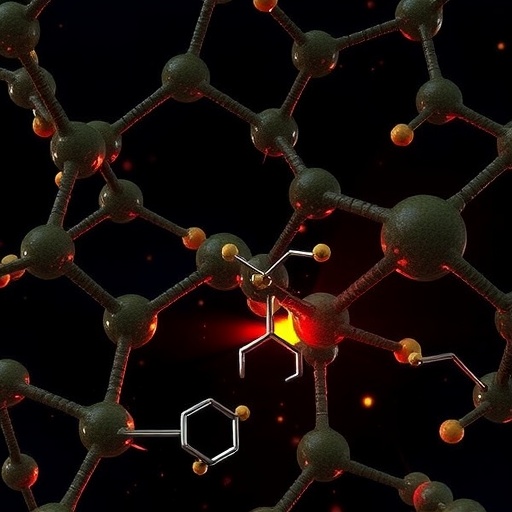In the dynamic field of medicinal chemistry, the continuous quest for innovative therapeutic agents remains at the forefront of scientific inquiry. Recent research by Dai, Z., Yang, D., and Wang, K. has surfaced remarkable advancements in the synthesis of novel compounds that possess the potential to combat pyroptosis and inflammation, two critical factors associated with various diseases. Emerging from their rigorous studies, these scientists have focused on developing derivatives of 3,4-dihydropyrazine[1,2-b]Indazole-1(2H)-one, aiming to elucidate their mechanisms of action and therapeutic efficacy.
Pyroptosis, an inflammatory form of programmed cell death, distinguishes itself from other cell death modalities through its unique biochemical pathways and physiological implications. This intricate process has garnered attention due to its involvement in numerous pathological conditions, including inflammatory diseases and neurodegenerative disorders. The capacity to modulate pyroptosis could pave the way for novel therapeutic interventions, and thus the synthesis of targeted inhibitors represents a monumental stride forward.
The intricate synthesis process explored by Dai and colleagues centers around multicomponent reactions (MCRs). This approach not only streamlines the development of complex molecular architectures but also minimizes environmental waste, signifying a sustainable direction in chemical synthesis. MCRs enable the simultaneous combination of multiple reactants into a single product, enhancing the efficiency of drug development. The team harnessed this methodology to generate unprecedented pyrazine derivatives, which were meticulously evaluated for their biological activities.
The research team’s exploratory focus on structurally diverse 3,4-dihydropyrazine derivatives yielded a spectrum of compounds, each with unique properties. By utilizing sophisticated analytical techniques, such as nuclear magnetic resonance (NMR), mass spectrometry, and high-performance liquid chromatography (HPLC), the researchers successfully characterized the synthesized compounds. These techniques provided essential insights into the molecular structure and purity of each derivative, laying the groundwork for subsequent biological evaluations.
The biological evaluation of these novel compounds involved an extensive array of in vitro assays designed to assess their inhibitory effects on pyroptosis and inflammation. By implementing cell-based models mimicking inflammatory conditions, the researchers meticulously quantified the extent to which these compounds could regulate key inflammatory markers. Preliminary findings intrigued the scientific community, showcasing the compounds’ ability to modulate pyroptosis pathways effectively.
Crucially, the impact of these novel derivatives on inflammation is underscored by their interactions with crucial signaling pathways such as the NLRP3 inflammasome. The NLRP3 inflammasome is an integral player in the regulation of the inflammatory response, mediating the secretion of pro-inflammatory cytokines. By modulating this pathway, the synthesized compounds could hold immense therapeutic promise, potentially mitigating the detrimental effects of chronic inflammation.
Dai and his team’s forward-thinking research does not merely augment the existing pharmacological landscape but rather introduces novel strategies for addressing pressing medical challenges. With a thorough understanding of the pharmacokinetic and pharmacodynamic properties of these compounds, the team is poised to elevate the discourse surrounding targeted therapies for inflammatory diseases. Their findings could catalyze new avenues for drug discovery, particularly in age-related inflammatory conditions, where preventive measures are paramount.
The implications of this research extend beyond the laboratory; they resonate with clinical applications in today’s healthcare environment. The promise of these novel pyrazine derivatives highlights the necessity for ongoing innovation within medicinal chemistry. Such advancements could potentially transform treatment paradigms, offering new hope for patients suffering from chronic inflammatory conditions and various forms of tissue damage.
Furthermore, the rigorous methodologies employed by Dai and colleagues reflect a broader trend in modern pharmacological research, emphasizing the importance of multidisciplinary approaches. Collaboration between chemists, biologists, and clinicians becomes increasingly vital as the pursuit of innovative therapies intensifies. The combination of diverse expertise fosters an environment conducive to groundbreaking discoveries, underscoring the interconnected nature of the scientific community.
The findings from this research contribute meaningfully to our understanding of the multifaceted roles of pyroptosis and inflammation in human health. As the scientific community delves deeper into understanding these interactions, the potential for transformative therapies continues to grow. The synthesized derivatives of 3,4-dihydropyrazine[1,2-b]Indazole-1(2H)-one are emblematic of the progress being made in this vibrant field.
Looking forward, the call to action involves not only the scientific community but also pharmaceutical companies and regulatory agencies to expedite the translation of these findings from bench to bedside. Expanding collaboration across sectors will facilitate more robust development pipelines for promising novel candidates. The confluence of advanced drug design, innovative synthetic methodologies, and a deeper understanding of disease biology holds the key to unlocking the next generation of therapeutics.
In conclusion, the pioneering work of Dai, Yang, Wang, and their research team encapsulates the spirit of discovery that drives progress in medicinal chemistry. Their efforts are a testament to the immense potential of targeted therapies, particularly those designed to modulate pyroptosis and inflammation. As we stand on the cusp of new medical frontiers, the significance of such research cannot be overstated, illuminating pathways toward healthier futures.
Subject of Research: Inhibitors of Pyroptosis and Inflammation
Article Title: Multicomponent reaction synthesis and evaluation of novel 3,4-dihydropyrazine[1,2-b]Indazole-1(2H)-one derivatives as inhibitors of pyroptosis and inflammation.
Article References:
Dai, Z., Yang, D., Wang, K. et al. Multicomponent reaction synthesis and evaluation of novel 3,4-dihydropyrazine[1,2-b]Indazole-1(2H)-one derivatives as inhibitors of pyroptosis and inflammation.
Mol Divers (2025). https://doi.org/10.1007/s11030-025-11312-5
Image Credits: AI Generated
DOI: 10.1007/s11030-025-11312-5
Keywords: 3,4-Dihydropyrazine, Pyroptosis, Inflammation, Multicomponent Reaction, Inhibitors, Medicinal Chemistry.




